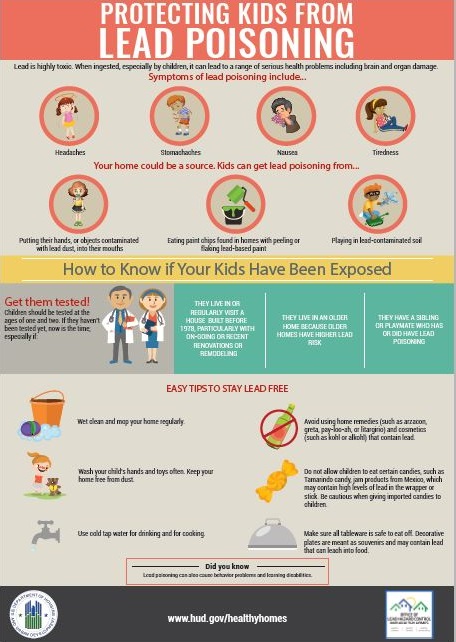CHILDREN & LEAD POISONING
Lead can damage nearly every system in the human body, and has harmful effects on both adults and children. It is a serious environmental public health threat, especially for children, in Ohio.
Children can be exposed to lead in many ways, but most exposure happens when children put things into their mouths while playing. Lead was used in house paint until 1978, and any house built before that year could have lead paint. Chips from this paint can be ingested or ground into dust, which can be eaten or breathed in. Lead can also be found in soil, water, and certain items that come from other countries. Many children with lead poisoning have no signs at first, which makes it hard to diagnose and treat their poisoning early.
Children under the age of 6 are most at risk due to their bodies ability to quickly uptake lead if exposed. NO amount of lead is safe for children or adults. Children should be tested if you believe they are at risk of coming into contact with any of the following risk factors:
- lead dust from remodeling
- paint chips.
- Lead pipes/ leaded drinking water
- Old toys made with lead.
- Living, visiting, or otherwise staying at buildings built before 1978.
- Contaminated pacifiers, cups, plates, and other items frequently put in the mouth.
Each year, approximately 160,000 children from birth to 6 years of age are screened for lead poisoning in Ohio and currently, less than 3 percent are found to have confirmed elevated blood lead levels.

Get the Facts
Lead is a metal that occurs naturally in the environment. Although lead can be found in small amounts in the earth’s crust, most of it comes from human activities such as manufacturing and mining. In the past, lead was used in gasoline, paint, metals, bullets, and batteries. We now know that lead has many hazardous health effects, and so lead has been banned or significantly reduced in these products.
Children can be exposed to lead in many ways, but most exposure happens when children put things into their mouths while playing. Lead was used in house paint until 1978, and any house built before that year could have lead paint. Chips from this paint can be ingested or ground into dust, which can be eaten or breathed in. Lead can also be found in soil, water, and certain items that come from other countries. Many children with lead poisoning have no signs at first, which makes it hard to diagnose and treat their poisoning early.
Even small amounts of lead can cause learning and behavior problems in children. Lead replaces iron and calcium and affects many parts of the body, especially the nervous system. Lead is most harmful to children under the age of six, because a child’s growing body takes up lead easily. Lead can also be dangerous to a baby during pregnancy. Problems related to lead poisoning can last the child’s whole life. Even at low levels, lead can lower IQ, cause attention disorders, make it difficult for a child to pay attention in school, delay growth, impair hearing, and more. Visit odh.ohio.gov/lead for more information.
Get Your Child Tested
Get Your Home Tested
If you live in a home built before 1978 and are considering a home renovation project, you should hire a certified inspector or risk assessor to check your home for lead-based paint or lead hazards by visiting www.epa.gov/lead/
- A lead-based paint inspection tells you if your home has lead-based paint and where it is located. › A lead risk assessment tells you if your home currently has any lead hazards from lead in paint, dust, or soil and what actions to take to address those hazards.
- A combination inspection and risk assessment tells you if your home has any leadbased paint or lead hazards and where both are located. Find a certified lead-based paint inspector or risk assesor at www.epa.gov/lead/
findaprofessional or call the National Lead Information Center at 1 (800) 424-LEAD [5323] (TTY 711). - Hire a lead-safe certified contractor who is trained in lead-safe work practices (a group of techniques to prevent lead exposure resulting from renovation and repair activities). Find a lead-safe certified contractor for renovation, repair, and painting jobs at www.epa.gov/lead/ f indacontractor.
- If you rent, ask your landlord to share previous test results or have your home or apartment tested for the presence of lead.
- To find out for certain if you have lead in your drinking water, have your water tested.Contact your local health department or water company to find out about testing your water or visit epa.gov/safewater for EPA’s lead in drinking water information.
—
